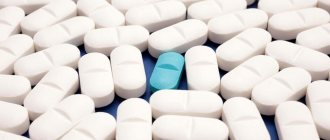Indications for use
For adults:
- Asthenic conditions, accompanied by increased drowsiness, lethargy, lethargy, apathy and decreased performance;
- Stuporous, substuporous and apatoabulic states;
- Asthenoneurotic disorders as a result of physical and mental fatigue, infections, intoxications, traumatic brain injuries;
- Sluggish schizophrenia with apatoabulic or asthenic disorders (in the absence of productive symptoms);
- Neurotic disorders accompanied by lethargy;
- Alcoholism, withdrawal syndrome, alcoholic adynamic depression;
- Correction of side effects of benzodiazepine tranquilizers (drowsiness and muscle relaxation) and neuroleptics (asthenic phenomena).
For children:
- Adynamia;
- Mental retardation;
- Organic diseases of the central nervous system with a predominance of asthenia, lethargy and lethargy.
There is evidence of the effectiveness of Sidnocarb for bedwetting.
Substance Sydnocarb
Instructions for medical use of the drug
Description of pharmacological action
It has a pronounced stimulating effect on the central nervous system; unlike phenamine, it does not have a distinct peripheral sympathomimetic activity and is not addictive (there is no weakening or absence of effect with prolonged repeated use).
Indications for use
Asthenic conditions (weakness) as a result of physical and mental fatigue, after serious illnesses and traumatic brain injuries, neurotic disorders with lethargy, sluggish schizophrenia with apatoabulic disorders (lethargy, lack of will). There is evidence of the effectiveness of the drug for bedwetting.
Release form
crystalline substance.
Use during pregnancy
Not recommended. Breastfeeding should be stopped during treatment.
Contraindications for use
Hypersensitivity, psychomotor agitation, atherosclerosis, arterial hypertension, simultaneous use of MAO inhibitors.
Side effects
Headache, irritability, anxiety, insomnia, loss of appetite, anorexia, increased blood pressure, allergic reactions; in patients with previously existing productive psychopathological symptoms - exacerbation of delusions and hallucinations.
Directions for use and doses
Prescribed 1-2 times a day in the morning (before meals). Doses are selected individually. The initial dose is usually 0.005 g (5 mg); if necessary, the dose is gradually increased in adults to 0.015-0.025-0.05 g per day. Maintenance doses - 0.005-0.01 g per day. For patients with lucid catatonia (a mental disorder with a predominance of motor disturbances in the form of agitation, stupor, or their alternation with preserved consciousness), the dose of the drug can be increased to 0.125-0.15 g (125-150 mg) per day. For children, debilitated patients and the elderly, the drug is prescribed in reduced doses (daily dose 0.0025-0.005 g in 2 doses). Higher doses for adults orally: single -0.075 g, daily - 0.15 g.
Overdose
In case of overdose, headache, insomnia, loss of appetite, increased blood pressure.
Storage conditions
List A. In a place protected from light.
Best before date
24 months
Directions for use and dosage
Sidnocarb should be taken orally before meals in the first half of the day.
Doses for each patient are selected individually. The recommended starting dose is 5 mg. If necessary, it is gradually increased to 15-25-50 mg per day. The average maintenance daily dose is 5-10 mg.
The maximum permissible doses for adults: single - 75 mg, daily - 150 mg, for patients with lucid catatonia it can be increased to 125-150 mg / day.
For elderly people, debilitated patients and children, Sidnocarb is prescribed at a dose of 2.5-5 mg in 2 doses.
Scope of application
Indications for use of the drug Sidnocarb:
- during a schizophrenic state with a sluggish character , especially if schizophrenia is accompanied by signs of an asthenic nature and the absence of obvious symptoms;
- with asthenia , during which there is an apathetic state, a feeling of increased drowsiness, a state of fatigue, confusion and deterioration of mental activity;
- with hypochondriacal neurosis ;
- during asthenic and neurotic syndromes with infectious, intoxication and traumatic damage to the central nervous system;
- the drug is prescribed for conditions of stuporous, apatoabulic and substuporous type ;
- if there is an asthenic condition that appears as a result of the use of tranquilizers and neuroleptics ;
- during periods of artificial exacerbation of schizophrenic symptoms ;
- the medication is used to eliminate signs of resistance (resistance) to psychoactive drugs ;
- to correct side effects caused by taking benzodiazepine anxiolytics ;
- with withdrawal syndrome, alcoholism , depression with an adynamic nature;
- used for inhibition of mental activity in children , aspontaneity, adynamia, disorders of the central nervous system (usually these conditions manifest themselves in the form of lethargy, lethargy, asthenic syndrome);
- with increased fatigue in people with a healthy psyche.
Cases of overdose and side effects
In case of an overdose of mesocarb, the following symptoms may appear:
- feeling drowsy;
- weakness;
- state of lethargy;
- sleep disturbance, namely insomnia;
- blood pressure may increase;
- decreased or complete lack of appetite.
If these symptoms appear, you should stop using the drug and consult a doctor.
Article on the topic: Ventolin - instructions for use for children and adults
When using the medication Sidnocarb, side effects occur in rare cases. Sometimes the following negative manifestations may appear:
- state of insomnia;
- the appearance of headaches;
- deterioration of appetite or its complete absence;
- Blood pressure levels may increase;
- the appearance of allergic reactions;
- feeling of restlessness, anxiety.
Application[ | ]
| The information in this section is out of date. You can help the project by updating it and then removing this template. |
Mesocarb was used for various types of asthenic conditions, occurring with lethargy, lethargy, apathy, decreased performance, hypochondria, and increased drowsiness [2]. It is effective in the treatment of stuporous, sub-stuporous conditions, asthenic and neurasthenic disorders in patients who have suffered intoxication, infections and brain injuries; in some schizophrenias with a predominance of asthenic disorders (in the absence of productive symptoms)[2]; with apato-abulic syndrome in schizophrenia and narcolepsy [6]. Mesocarb can also be used to artificially aggravate the schizophrenic process in order to overcome the state of resistance to therapy with psychotropic drugs[3][2].
Mesocarb is an effective remedy that relieves asthenic phenomena that occur when using antipsychotic drugs [2]. It is an effective corrector that reduces or removes side effects (muscle relaxation, drowsiness) caused by benzodiazepine tranquilizers (phenazepam, etc.)[2][7]; however, it does not reduce the tranquilizing effect. The optimal dose ratio of phenazepam and mesocarb is 1:1.25 or 1:2.5 (at higher doses of mesocarb 1:5, night sleep disturbance may occur)[2]. Mesocarb can be prescribed simultaneously with phenazepam or in case of already developed side effects[2]. Preliminary application of mesocarb is less effective[2].
Mesocarb can be recommended for the treatment of patients with alcoholism with a predominant clinical picture of lethargy, lethargy, as well as asthenoneurotic reactions during the period of “alcohol withdrawal”, with alcoholic depression with adynamic symptoms [2]. Given the stimulating effect of mesocarb, it can be used to reduce withdrawal symptoms [2].
In combination with antidepressants, it was used to treat depression with apathy and lethargy[3].
Mesocarb is also effective in children with mental retardation, adynamia, spontaneity, organic diseases of the central nervous system with a predominance of lethargy, lethargy, and asthenia in the clinical picture [2]. Significant effectiveness of mesocarb in the treatment of hyperdynamic syndrome in young children has been noted[8][2].
The drug is also effective for bedwetting[6][2].
Mesocarb is usually well tolerated. In case of an overdose, increased irritability and anxiety are possible. An increase in delusions and hallucinations is possible in patients with previously existing productive psychopathological symptoms. Sometimes there is a decrease in appetite. A moderate increase in blood pressure is possible. Side effects disappear when the dose is reduced or the drug is temporarily stopped.
Due to its high efficiency and good tolerability, mesocarb has almost completely replaced amphetamine.
Mesocarb should not be prescribed to excited patients or with symptoms of irritable weakness. Caution is required in cases of pronounced atherosclerosis and severe forms of hypertension. To avoid disruption of night sleep, you should not take the drug in the evening.
Given the strong stimulating effect of mesocarb, it should be prescribed strictly according to indications, not for too long.
Practical application experience
Review by a practicing physician and patient reviews of the drug Sidnocarb.
Sidnocarb is a psychostimulant drug. Its use allows you to quickly restore the nervous system and psyche. Schizophrenia, asthenia, depression are the main indications for the use of the drug Sidnocarb.
In addition, the medicine can be used for other diseases of the nervous system, but it must be taken strictly according to the instructions, or according to the regimen prescribed by the doctor. It is better to first consult with a specialist who will determine the dosage and duration of the course of use of the drug.
Psychotherapist
Recently I have noticed increased lethargy, fatigue and a constant feeling of drowsiness. At first, coffee saved me, but over time it stopped helping me and it only got worse. I just fell asleep while walking.
All these symptoms simply did not allow me to live or work normally. I consulted a doctor who, after an examination, diagnosed asthenia and prescribed a course of Mesocarb. I took this remedy according to the doctor's instructions. After 2 weeks I felt much better.
Evgeniy, 45 years old
My 10-year-old daughter recently began to notice that she had become lethargic, had problems with her studies, and had decreased performance. If at first all these symptoms did not manifest themselves strongly, then over time they only intensified.
Then I decided to go with her to a pediatric neurologist. After consultation, we were prescribed the drug Sidnocarb. I gave it to my daughter in the dosage prescribed by the doctor. She took it for about 2 weeks. During this time she became much better.
Svetlana, 38 years old
Sidnocarb: complete instructions for use
The pills are intended for oral use; drink them immediately before the main meal (preferably during the first half of the day).
Usually the medication is prescribed once or twice a day. The dosage of the drug is determined individually depending on the nature of the pathological process and its severity. Adults are recommended to begin treatment therapy with minimal dosages - 0.005 g, and subsequently increase the dose of drugs to 0.015 - 0.05 g per day.
When carrying out therapy in persons with lucid catatonia, it should be taken into account that therapeutic effectiveness will manifest itself when taking increased dosages - up to 0.15 g of drugs per day.
Elderly people, children and people who have suffered serious illnesses should take a reduced dose of the medicine; it should not exceed 0.0025 - 0.005 g per day. The highest daily dosage of the drug is 0.15 g. Treatment is carried out until the doctor is convinced that you are completely healthy.
Treatment with Phenazepam is possible.





